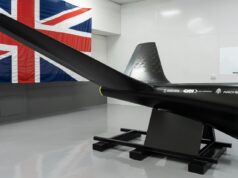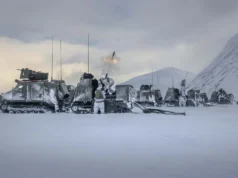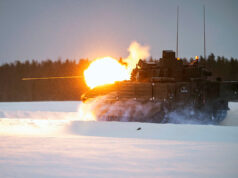Exercise Terminal Strike recently took place in the challenging terrain of the Scottish Highlands, and provided a valuable training opportunity for Royal Artillery and Royal Armoured Corps Joint Terminal Attack Controllers (JTACs), say the British Army.
Joint Terminal Attack Controllers facilitate Close Air Support in direct support of ground units. Close Air Support has been a key force multiplier on the battlefield since 1918. Forward Air Controllers (now called JTACs) have been employed within the British Military since 1941, say the Army in a news release.
“By the end of the exercise soldiers will maintain their qualification as ‘Joint Terminal Attack Controllers’ or JTACs and they have been training in five locations across Scotland, North East England and the East Anglian coast. Normally taking place over two weeks, twice a year, Exercise Terminal Strike was extended to 4-weeks to maximise on Operation Shader preparations for those due to deploy in early 2019.
The UK Military currently draws JTACs from serving personnel from the Royal Navy (Royal Marines), British Army (Royal Artillery and Royal Armed Corps) and Royal Air Force (RAF Regiment) for service within 3rd (United Kingdom) Division, 1st Artillery Brigade, 1st Intelligence, Surveillance and Reconnaissance Brigade, 3 Commando Brigade, 16 Air Assault Brigade, RAF Force Protection Force (RAF Regiment) and within the Special Forces Support Group.”














Dangerous work but sounds fun. Do AR do this training e.g. HAC? 21 or 23?
Been waiting for someone in the military who knows for sure to answer, but I don’t think so.
HAC is specialist S & TA patrols ( 1 Squadron) where’s 21 and 23 are doing HERA work now they’ve been removed from DSF.
I believe 5 RA carry out most of this work, along with 148 RA.
Happy to be corrected and would be interested to know for sure myself.
There was a small unit at Leeming working with 100 Sqn Hawks too. ( JFACTU )
Sorry Riga and Daniele, I can put some meat on the bones. Daniele is correct with 21/23 now doing HERA, but HAC do the STA work, and in doing so also have a 3 Gun Troop of 105mm, as back fill to 7RHA. The JTAC came into its current form, as in the early days of Herrick (4) we had FOO parties from the Guns, MFCs and FACs, forming teams and being called TAC parties. The JTAC came about as the airspace got more complicated, while not contested, but a lot more de-confliction was needed, and swifter and more seamless procedures were necessary.
The TAC parties then became massive force multipliers, and you didn’t leave the FOB without one. The JTAC course was therefore quite a common one, and in fact not enough guys were pushed through initially. While Herrick was in its serious kinetic phase, Herricks 4-9 mainly, JTACs were trained from every Infantry Battalion and some supporting arms. They then could deploy individually, or as part of a team. I know the Arty lads pushed through a hell of a lot of people on JTAC, as “Foo”ing and call for fire with the OP teams was their bread and butter, but anyone could train up and become a JTAC, if put forward by their unit, and if the requirement was there operationally.
5 Regiment is the home of a number of role specific Batteries, from mortar location with MAMBA, 4/73 Bty STA (STA Special Observer, as historically the RA had stay behind patrols, who’s job was to dig a hide, wait for the Russkies to role over them, and call in fire at the rear echelons HVTs along with 21/23 regiments) and other acoustic location and camera STA equipment equipped Btys. Daniele 148 do NGS, which is a slightly more complicated set of “op”ing, as the guns (or one gun, naval 4.5”) is moving and not static, and that itself brings its own set of role specific procedures, but yes they also have the JTACs as and when needed for operations, and a decent set of well trained fellahs they are…….I suppose lol.
Thanks for the detail Airborne. Was well aware 148 do NGS by the way. ? they themselves are para trained too I believe?
Just a heads up for anyone interested there’s an interesting article on Defenseone website about a new US standard rifle calibre.
6.8mm I believe?
It will be interesting to see how the rest of the US military reacts. Logistically it will be more of a headache, and I recall reading a report that the 6.8mm round only offers marginal ballistic improvements over the NATO standard round. Considering the USMC also recently announced it is standardizing to the HK416, and the rest of NATO has no current plans to move away from 5.56mm, it is quite an interesting choice. The L85A3 will be getting rolled out over the coming years to UK forces so no change on the horizon for us.
I suppose they are building on experience from Iraq and Afghanistan where the penetration, and therefore ‘transfer of energy’ with 5.56 was in some cases insufficient to ‘drop’ a target cold. I assume the thinking is 6.8mm offers some middle ground between 7.62mm and the NATO standard?
I wonder how it performs recoil wise on full auto? I imagine a heavier caliber on a relatively light weapon system such as an M4 type would take some holding on to! The good old AK-47 certainly did! 🙂 Good fun though!
One of the big problems that the U.S. military is trying to overcome is many types of body armor will defeat the 5.56 round (even the 62 grain steel core) and it’s only going to get worse. Sooner or later I think you’ll see NATO following the U.S. lead.
Cheers.